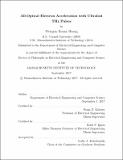| dc.contributor.advisor | Franz X. Kärtner and Erich P. Ippen. | en_US |
| dc.contributor.author | Huang, Wenqian Ronny | en_US |
| dc.contributor.other | Massachusetts Institute of Technology. Department of Electrical Engineering and Computer Science. | en_US |
| dc.date.accessioned | 2018-03-02T21:39:41Z | |
| dc.date.available | 2018-03-02T21:39:41Z | |
| dc.date.copyright | 2017 | en_US |
| dc.date.issued | 2017 | en_US |
| dc.identifier.uri | http://hdl.handle.net/1721.1/113930 | |
| dc.description | Thesis: Ph. D., Massachusetts Institute of Technology, Department of Electrical Engineering and Computer Science, 2017. | en_US |
| dc.description | This electronic version was submitted by the student author. The certified thesis is available in the Institute Archives and Special Collections. | en_US |
| dc.description | Cataloged from student-submitted PDF version of thesis. | en_US |
| dc.description | Includes bibliographical references (pages 203-214). | en_US |
| dc.description.abstract | This thesis discusses a series of advances toward - and resulting in - the demonstration of the first ultrafast THz-driven electron gun, a technology with the potential to deliver unprecedented electron beam quality to scientists studying matter at the ultrafast and ultrafast scale via electron diffraction or x-ray imaging. In Part 1, we discuss various advances in generation of high energy pulsed THz radiation, a spectral regime uniquely eective at accelerating electrons but historically lacking in ecient sources. In particular, through various improvements to the grating-based tilted pulse front (TPF) technique, we demonstrate a record conversion eciency of 1%. We also implement echelon-based TPF, achieving 3.5x higher eciency than grating-based TPF for short (~100 fs) pulses. Finally, we reuse the residual pump to obtain a recycled eciency around half to a quarter that of the original. This reduced eciency can be linked to spatio-spectral distortions in the residual pump, and we characterize these distortions to better understand the asymmetric dynamics of the THz generation process. In Part 2, we discuss the design, testing, and commissioning of an electron gun driven exclusively by THz radiation. The accelerating structure, capable of broad-band, dispersionless THz propagation and sub-wavelength confinement, is analyzed through electromagnetic simulations and experimental tests. We also characterize the accelerated electrons in absolute charge and spectrum as a function of emission phase and THz energy, while showing that the behavior matches well with theory and simulation. Our first-version THz gun delivers near 1 keV electrons accelerated by field strengths surpassing that of the best operational RF guns. The gun also delivers narrowband electron spectra which can already be used for low-energy electron diffraction. | en_US |
| dc.description.statementofresponsibility | by Wenqian Ronny Huang. | en_US |
| dc.format.extent | 214 pages | en_US |
| dc.language.iso | eng | en_US |
| dc.publisher | Massachusetts Institute of Technology | en_US |
| dc.rights | MIT theses are protected by copyright. They may be viewed, downloaded, or printed from this source but further reproduction or distribution in any format is prohibited without written permission. | en_US |
| dc.rights.uri | http://dspace.mit.edu/handle/1721.1/7582 | en_US |
| dc.subject | Electrical Engineering and Computer Science. | en_US |
| dc.title | All-optical electron acceleration with ultrafast THz pulses | en_US |
| dc.type | Thesis | en_US |
| dc.description.degree | Ph. D. | en_US |
| dc.contributor.department | Massachusetts Institute of Technology. Department of Electrical Engineering and Computer Science | |
| dc.identifier.oclc | 1023811320 | en_US |
